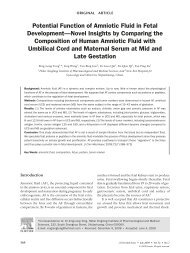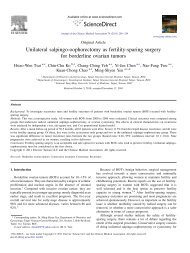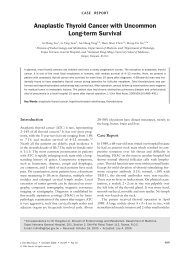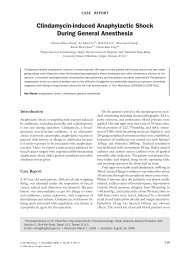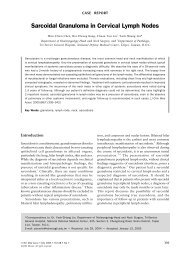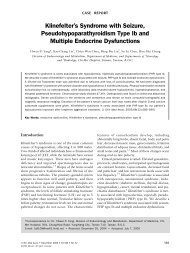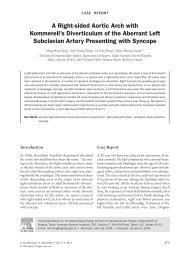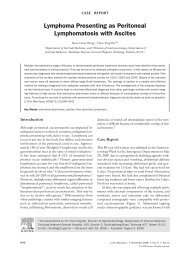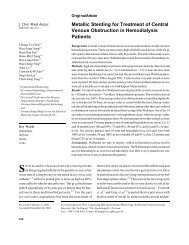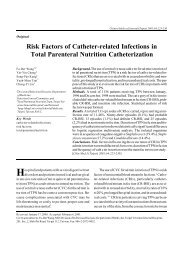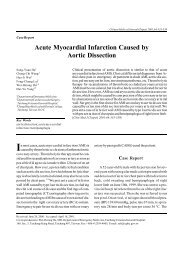Surgical Anatomy of Supratentorial Midline Lesions
Surgical Anatomy of Supratentorial Midline Lesions
Surgical Anatomy of Supratentorial Midline Lesions
Create successful ePaper yourself
Turn your PDF publications into a flip-book with our unique Google optimized e-Paper software.
After cutting through the medial portion <strong>of</strong> the corpus callosum, the crus <strong>of</strong> the fornix and the hippocampal commissure are exposed.<br />
The fimbria can be traced to the crus, body, and column <strong>of</strong> the fornix, and terminates in the mammillary body. The frontal horn, body,<br />
and atrial portions <strong>of</strong> the lateral ventricle with the choroid plexus, as well as the head and body portions <strong>of</strong> the caudate nucleus are<br />
demonstrated (Figure 1C).<br />
The hippocampus, choroid plexus, fimbria, crus, and body portions <strong>of</strong> the fornix compose the entire anatomy <strong>of</strong> the lateral ventricle.<br />
After further removal <strong>of</strong> the medial frontoparietal cortex, removal <strong>of</strong> the cingulum and further dissection <strong>of</strong> the corpus callosum<br />
reveals the radiating fibers <strong>of</strong> the corpus callosum. The callosal fibers form a major portion <strong>of</strong> the commissural system and serve to<br />
interconnect the hemispheres. The genu portion <strong>of</strong> these fibers is known as the forceps minor, and the splenial portion is called the<br />
forceps major. The uncus is deflected to separate the amygdala from its complex connections, revealing the temporal horn <strong>of</strong> the<br />
lateral ventricle. The hippocampus is dissected free <strong>of</strong> the collateral eminence to gain entrance in to the collateral sulcus. The tail <strong>of</strong><br />
the hippocampus and the fornix are separated from the choroid plexus along the choroidal fissure. The fornix is incised at the junction<br />
<strong>of</strong> the body and column, and the choroid plexus is removed along the choroidal fissure. The stria terminalis, located between the<br />
caudate nucleus and thalamus, connects the bed nucleus <strong>of</strong> the stria terminalis and parts <strong>of</strong> the hypothalamus to the amygdala<br />
(Figure 1D).<br />
The removal <strong>of</strong> the frontal horn ependyma (which is a single layer <strong>of</strong> specialized epithelium lining the ventricles) and the body <strong>of</strong> the<br />
lateral ventricle allows exposure <strong>of</strong> the head and body <strong>of</strong> the caudate nucleus and the subcallosal stratum. The subcallosal stratum is<br />
a subependymal structure located between the caudate nucleus and the radiations <strong>of</strong> the corpus callosum. The caudate nucleus is<br />
observed to ex tend along the wall <strong>of</strong> the lateral ventricle and the tail <strong>of</strong> the caudate reaches forward to the level <strong>of</strong> the amygdala. The<br />
caudate nucleus has the same s<strong>of</strong>t consistency as the put amen. Removal <strong>of</strong> the head and body portions <strong>of</strong> the caudate nucleus<br />
reveals the anterior and superior thalamic peduncles. The next step involves dissecting away the anterior portions <strong>of</strong> the subcallosal<br />
stratum and the radiations <strong>of</strong> the corpus callosum to allow identification <strong>of</strong> the extensions <strong>of</strong> the anterior and superior thalamic<br />
peduncles to the cortex. These peduncles are the anteromedial portion <strong>of</strong> the internal capsule, and they connect the frontoparietal<br />
regions <strong>of</strong> the cortex with the thalamus (Figure 1E).<br />
After total removal <strong>of</strong> the ependyma lining the lateral wall and ro<strong>of</strong> <strong>of</strong> the lateral ventricle, the posterior portion <strong>of</strong> the subcallosal<br />
stratum and the tapetum <strong>of</strong> the corpus callosum are demonstrated, both <strong>of</strong> which were found to be subependymal structures. The<br />
tapetum, a subgroup <strong>of</strong> callosal fibers in the splenial region, forms the ro<strong>of</strong> and lateral wall <strong>of</strong> the atrial portion <strong>of</strong> the lateral ventricle<br />
and sweeps around the temporal horn, thereby separating the fibers <strong>of</strong> the optic radiation from the temporal horn. Further removal <strong>of</strong><br />
the caudate nucleus exposes the posterior and inferior thalamic peduncles. During our fiber dissection, identification <strong>of</strong> the precise<br />
location <strong>of</strong> the border separating the tapetum and the subcallosal stratum eluded us. Nevertheless, we did note a distinct difference<br />
between these two structures, and we suspect that the border lies be tween the body and the atrial portions <strong>of</strong> the lateral ventricle. In<br />
the subcallosal stratum, we were unable to identify a definite fiber system. There was, however, a fiber system clearly present in the<br />
tapetum. In addition, we made a significant observation; that the subcallosal stratum has fine, microscopic connections with the<br />
superior margin <strong>of</strong> the caudate nucleus (Figure 1F).<br />
The tapetum extends from the splenium, forming the lateral wall <strong>of</strong> the atrium and the ro<strong>of</strong> <strong>of</strong> the temporal horn beneath the<br />
ependyma. After removing the remaining posterior layer <strong>of</strong> the subcallosal stratum, we dissected away the tapetum, the stria<br />
terminalis, and the amygdala, exposing the entire anatomy <strong>of</strong> the anterior, superior, posterior, and inferior thalamic peduncles as well<br />
as the optic radiation over the ro<strong>of</strong> <strong>of</strong> the temporal horn. Resection <strong>of</strong> the body <strong>of</strong> the corpus callosum further exposed the superior<br />
thalamic peduncle. The thalamic peduncles as a whole form the medial portion <strong>of</strong> the internal capsule and connect the cerebral<br />
cortex to the thalamus. The inferior thalamic peduncle connects the temporal lobe to the thalamus. Following the column <strong>of</strong> the fornix<br />
into the hypothalamus demonstrates its connection with the mammillary body. The anterior commissure is located anterior to the<br />
column <strong>of</strong> the fornix. Further dissection into the hypothalamus and thalamus reveals the column <strong>of</strong> the fornix, optic tract, mammillary<br />
body, and mammillothalamic tract, which is also known as the tract <strong>of</strong> Vicq d'Azyr. Extensive dissection into the thalamus reveals its<br />
connections with the thalamic peduncles (Figure 1G).<br />
Removal <strong>of</strong> the anterior, superior, posterior (which includes the optic radiation), and inferior thalamic peduncles together with the<br />
thalamus and the lateral geniculate body concludes the dissection and demonstrates the whole corona radiata and the lateral portion<br />
<strong>of</strong> the internal capsule from a medial view, and the cerebral peduncle. These structures are composed <strong>of</strong> frontopontine fibers,<br />
pyramidal tract, and occipitopontine and temporopontine fibers (Figure 1H).<br />
<strong>Surgical</strong> Considerations<br />
The striking advances in neurovisualization technology confirm the observations <strong>of</strong> neuropathologists, neurologists, and<br />
neurosurgeons that each type <strong>of</strong> CNS lesion has a predilection to present in distinct sites in osseous, meningeal, cisternal,<br />
parenchymal, ventricular, or vascular compartments. In each <strong>of</strong> these locations, the lesions may <strong>of</strong>ten reach a considerable size<br />
without causing any or only discreet signs and symptoms. It can be assumed that a lesion may compress and displace normal brain<br />
structures to a greater degree, but lack the capacity to transgress and destroy the unique architecture <strong>of</strong> the gray and white matter <strong>of</strong><br />
the CNS. This fact affords us the opportunity to devise and initiate adequate treatment plans.<br />
The main principle <strong>of</strong> a neurosurgical procedure is always to perform a pure lesionectomy, using tactics to avoid compromising<br />
normal homeostasis <strong>of</strong> the CNS. This surgical principle becomes a challenge to uphold when considering deep, localized, so-called<br />
"midline lesions," which may originate from the medial part <strong>of</strong> the frontal, parietal, or occipital lobe; from the anterior, middle, or<br />
posterior parts <strong>of</strong> the cingulate gyrus; from the parasplenial region (posterior cingulate gyrus, inferior precuneus, and posterior<br />
parahippocampal gyrus); corpus callosum; thalamus; hypothalamus; or third and lateral ventricles. All lesions in these locations<br />
(tumors, AVMs, and cavernomas) can be explored and removed through an anterior, middle, or posterior interhemispheric, and<br />
supracerebellar-infratentorial approach (Figure 2). The specific method <strong>of</strong> these approaches prevents infliction <strong>of</strong> harm to the dorsal<br />
neopallial areas and to the connective fiber systems <strong>of</strong> the white matter.



